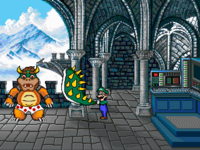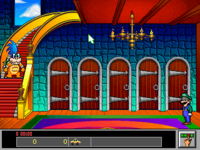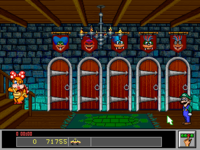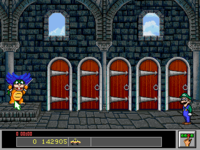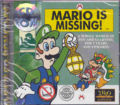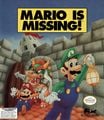Mario is Missing!
Template:Infobox Mario is Missing! is an educational game created for MS-DOS, the SNES, and the NES. The gameplay was widely panned by critics, although its Super Mario World music remixes have gained recognition. Mario is Missing! was released in floppy disk format for MS-DOS in 1992, with the CD-ROM Deluxe edition and console versions released the following year. A follow-up called Mario's Time Machine was eventually produced. This is the first game where Luigi is the main protagonist with Mario in a supporting role and it was the only solo adventure for Luigi until 2001 when Luigi's Mansion was released on the Nintendo GameCube.
Story
Bowser decides to flood the Earth using hairdryers from Hafta Havit Mail-Order to melt Antarctica. In order to buy the hairdryers, Bowser has his Koopa Troopas travel all over the world and steal various important landmarks that he plans to sell.
Mario, Luigi and Yoshi follow Bowser to Antarctica to stop him, but when Mario goes on ahead he is captured by Bowser. The PC version is the most elaborate: Luigi is too scared to go inside the castle, so Mario enters alone. Despite Luigi's warnings against taking candy from strangers, Mario eats some candy offered to him by Bowser (disguised as a butler), and is then scooped up in a net. In the SNES version, a pit opens up beneath him when the group reaches the castle, while in the NES version, a Koopa throws a bag over him as he walks through the snow and ice.
With Mario captured, the task of returning all the stolen artifacts and saving both his brother and Earth falls to Luigi, who bravely enters the castle, leaving Yoshi outside.
Story from console instruction booklet
Bowser's Plot
Oh no! Bowser and his bad boys are back to a life of crime. This time, it's not Mario World — it's your world! From his Antarctic castle, Bowser hustles his cold-blooded crew of cantankerous Koopas into his powerful Passcode Operated Remote Transport And Larceny System (PORTALS). The twisted turtles transport themselves throughout the globe, where celebrated cities suffer shell-shocking crime waves, as turtles trash landmarks and loot ancient artifacts. With dough from his slimy scales, Bowser hoards hair dryers from the Hafta-Havit Hotline. His plot? Melt Antarctica and flood the planet! Whoa!
Mario's Fate
Will the brave brothers from Brooklyn permit this abominable snow plan? The boys say "Not!" Mario, Luigi and Yoshi trek across ice and snow to shellac the shelled ones' schemes. But Bowser's slick; in one last trick, he takes the dearest thing of all...Mario is Missing!
Luigi's Mission
Luigi must stop the Koopas, foil Bowser's plan, and find Mario. Sneaking into each Portal, Luigi is transported to a city in trouble. There, Luigi needs to nab each Koopa, grab its loot, and return the artifact to its proper landmark. Along the way, Luigi explores the city, chats with the locals, reads maps, and solves puzzles. Help him do this before time runs out! Once he figures out where he is on the globe,
Luigi must use the Globulator to call Yoshi. Only after Yoshi scares Pokey away, can Luigi return to Bowser's castle and lock the Portal for that city.
Ending
In the DOS version, Luigi takes Bowser's shell (which covers his tail in this depiction) off, causing Bowser to run off screen, embarrassed about his polka-dot boxers. This is the only time Bowser's been seen in his Beach Koopa form. Luigi shakes the shell to retrieve the key to Mario's cell, and then throws the carapace away. Bowser returns wondering where his shell is, Luigi then lies to him saying he threw the shell off the balcony; then, when Bowser leans over the railing to look for it, Luigi kicks him off and he lands in the snow. Luigi then opens Mario's cell and the two dance around in joy. They then go outside and shake Yoshi's hand, before walking off into the distance together. Bowser then pokes his head out of the snow, looking in their direction with his shell back on.
In the Macintosh version, Bowser doesn't run off after his boxers are revealed, and Luigi smacks him off the balcony with his own shell.
In the SNES version of the ending, Luigi pulls a lever to reveal Mario behind a wall. Bowser then jumps down from a distant ledge, but Luigi pulls the same lever, causing Bowser to fall down into a cannon. He is then launched out of the castle and into the snow, where he freezes instantly and then shatters. In the NES version, Luigi and Bowser have a boss battle and "Bowser" turns out to be a normal Koopa Troopa in disguise, who turns the key to Mario's cell, freeing him. The brothers are later seen back outside with Yoshi and Bowser, the latter of whom is crying over his defeat.
Characters
- Luigi
- Mario
- Yoshi
- Bowser
- Koopa Troopa
- Pokey (PC and SNES)
- Larry Koopa (PC)
- Roy Koopa (PC and SNES)
- Wendy Koopa (PC)
- Iggy Koopa (PC and SNES)
- Ludwig von Koopa (PC and SNES)
- Princess Peach (CD-ROM Deluxe only)
- Toad (CD-ROM Deluxe only)
- Donkey Kong (CD-ROM Deluxe only)
- Monty Mole (CD-ROM Deluxe only)
- Dino Rhino (CD-ROM Deluxe only)
Gameplay
In each level, Luigi must retrieve several artifacts which were stolen by several Koopa Troopas within the city and return them to their rightful places. Luigi must jump on the Koopa Troopas to defeat them and reclaim the artifacts, which he then takes back to the landmarks they were stolen from. He must answer trivia questions about the landmarks before the curators will take the wares back. In the SNES version, all the information kiosks are manned by women resembling Princess Daisy (complete with crown), although this is an unconfirmed appearance.
The DOS version adds a videophone aspect to gameplay, and Luigi must call the help number provided at the landmarks to get in touch with his friends, answer the questions, return the artifact, and receive a monetary reward. The mayor of the city also phones Luigi when he arrives, asking for his help in stopping the Koopas; he later phones when Luigi secures the city, thanking him and wishing him luck in finding Mario. The red plumber himself even manages to phone Luigi, giving him advice on his journey as well as updates on his capture and the Koopas' struggle to maintain their plot as planned. The DOS version also has a Taxi feature, in which Luigi collects little Taxi tokens around the city and then exchanges them for rides across town. The SNES version instead uses more Warp Pipes to facilitate speedy travel.
As well as returning the artifacts, Luigi must also deduce what city he's in so that he can use the Globulator and call Yoshi to his aid for double the walking and running speed. Without Yoshi, Luigi cannot finish the level, as the exit pipe is occupied by a large Pokey. Yoshi proceeds to gobble the Pokey up in the DOS version, whereas the Pokey is merely scared away by Yoshi's presence in the SNES release.
Once Luigi has secured all the cities whose doors are located on a floor of the castle, Luigi must use a Fire Flower collected in the cities to defeat them using their only weakness - Fire. The console releases remove the Fire Flower in favor of a small boss battle. However, the bosses cannot hurt Luigi, and must be stomped on a certain number of times to be defeated in the SNES and NES versions. The console versions also differ in that the Koopa Troopas are not defeated when they are knocked about and forced to leave in an undignified manner, but rather a sound stomp with destroy them upon impact (including the shell).
In addition, there was a later enhanced edition for PC known as the CD-ROM Deluxe version. It included full-on voice acting to go along with the dialogue, although not all of the in-game text matched the audio exactly. The voice actors are known (Kathy Fitzgerald, Rob Wallace, Bob Sorenson, Nicholas Glaeser, David Gill), but the game does not specify which of them supplied which voices. There are also some graphical changes, such as loading screens when the screen is black, and icons of Princess Toadstool, Toad and Donkey Kong replace a recurring phone call NPC (although the old dialogue was not changed on-screen). The viewings of every historic spot in particular were originally recreated and shown in garish coloring. The CD-ROM Deluxe version replaces most of these pictures with realistic photographs and even live-action video clips to represent the landmarks, with some exceptions carried over from the floppy disk version.
Cities
MS-DOS
- First Floor
- Rome, Italy (Europe) 1st door
- Nairobi, Kenya (Africa) 2nd door
- Beijing, China (Asia) 3rd door
- Moscow, Russia (Europe) 4th door
- San Francisco, United States (North America) 5th door
- Second Floor
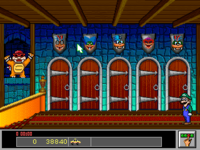
- Athens, Greece (Europe) 1st door
- Madrid, Spain (Europe) 2nd door
- Marrakech, Morocco (Africa) 3rd door
- Mexico City, Mexico (North America) 4th door
- Paris, France (Europe) 5th door
- Third Floor
- Berlin, Germany (Europe) 1st door
- Buenos Aires, Argentina (South America) 2nd door
- Dublin, Ireland (Europe) 3rd door
- Kathmandu, Nepal (Asia) 4th door
- Sydney, Australia (Oceania) 5th door
- Fourth Floor
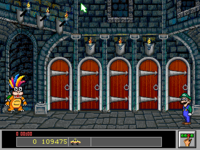
- Amsterdam, Netherlands (Europe) 1st door
- Bombay, India (Asia) 2nd door
- Cairo, Egypt (Africa) 3rd door
- Tokyo, Japan (Asia) 4th door
- Toronto, Canada (North America) 5th door
- Fifth Floor
- Istanbul, Turkey (Europe) 1st door
- Jerusalem, Israel (Asia) 2nd door
- London, United Kingdom (Europe) 3rd door
- New York City, United States (North America) 4th door
- Rio de Janeiro, Brazil (South America) 5th door
SNES version
- First floor
- San Francisco, California, USA (North America)
- Moscow, Russia (Europe)
- Nairobi, Kenya (Africa)
- Beijing, China (Asia)
- Rome, Italy (Europe)
- Second floor
- Paris, France (Europe)
- Mexico City, Mexico (North America)
- Sydney, Australia (Oceania)
- Buenos Aires, Argentina (South America)
- Athens, Greece (Europe)
- Third floor
- London, United Kingdom (Europe)
- Cairo, Egypt (Africa)
- Tokyo, Japan (Asia)
- Rio de Janeiro, Brazil (South America)
- New York City, New York, USA (North America)
NES version
- First room
- New York City, New York (United States)
- Rome, Italy
- Second room
- Sydney, Australia
- San Francisco, California (United States)
- Third room
- Fourth room
- Fifth room
- London, England
- Buenos Aires, Argentina
- Sixth room
- Mexico City, Mexico
- Cairo, Egypt
- Seventh room;
Gallery
Boxart
Screenshot comparisons
- AdobeNairobiSNES.PNG
Super NES version
- AdobeNairobiNES.PNG
NES version
- Ss mim-pc t.png
PC title screen
- Ss mim-snes title.png
SNES title screen
- Ss mim-nes t.png
NES title screen
Adverts
Quotes
- Main article: List of quotes in Mario is Missing!
Pre-release and unused content
Unused data
Dialogue intended for the ending of the game is discovered in the CD-ROM Deluxe edition of the game: Game ending reconstructed with voices.
It also appears that Lemmy and Morton were going to appear in game, as their unused dialogue was found and ripped on the description of the following page: Ripped voices from PC Engine.
Reception
Sales
In an August 1993 press release, Software Toolworks claimed that sales of the console versions of Mario is Missing! exceeded $7,000,000 for the fiscal quarter and that the game boosted the company's revenue during a slow quarter[1].
Staff
- Main article: List of Mario is Missing! staff
Trivia
- According to the MS-DOS release, Mario has a fear of the dark, which he is increasingly worried that Bowser will exploit in torture. This is not seen or referenced in other games, except potentially Hotel Mario when he stutters before entering the cave hotel without a flashlight.
- Mario's voice is inconsistent in the the CD-ROM Deluxe edition. Sometimes he has an Italian accent, sometimes he has a New York accent with a slight hint of Italian.
- Luigi, however, has a consistent New York accent.
- The Koopa Troopas look similar to their original Super Mario Bros. artwork in the MS-DOS version, and instead of merely walking around, they use various modes of transportation, such as parachuting or skateboarding.
- Every Koopaling but Lemmy and Morton appears in at least one version of this game.
- In addition, although some Mario media supply voice acting for the Koopalings, the CD-ROM Deluxe edition is the first game to have the Koopalings voiced, as well as the only game to actually supply them with dialogue. Later games starting with New Super Mario Bros. Wii have the Koopalings voiced, although it is limited to roars and grunts.
- The USA and Canada are the only countries that are visited twice at different cities in all versions of the game (New York and San Francisco in USA, Toronto and Montreal in Canada).
- Luigi's sprite in the PC version started the internet meme, Weegee.
- The Mario, Luigi and Yoshi sprites in the NES and SNES versions were taken from Super Mario World.
References
- ^ "Software Toolworks reports 41-percent gain in revenues for the June quarter; quarterly loss narrows to -2 cents per share." The Free Library. 1993 PR Newswire Association LLC 19 Jul. 2014 http://www.thefreelibrary.com/SOFTWARE+TOOLWORKS+REPORTS+41-PERCENT+GAIN+IN+REVENUES+FOR+THE+JUNE...-a013213765
Template:BoxTop Template:Mariogames
